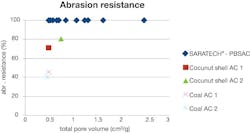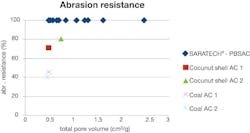Wherever water is treated by adsorption vessels are necessary. Mostly fixed bed filters, where the water is guided through an adsorptive bulk, are used. Conventional activated carbon (abr. AC) is very often an adsorptive material. This process is well known and easy to handle. It is defined for dimensioning by filter velocity; minimum retention time (EBCT); holding time and operational availability.
Another solution are moving bed adsorbers which have been installed and continuously improved since the 60's, but they also have their limitations (reduced abrasion resistance of conventional AC and the tendency to bridging), reason why they are not widely used.
The outstanding mechanical properties and the excellent results Blücher has obtained with its SARATECH® polymer based spherical activated carbon (abr. SARATECH-PBSAC) in terms of capacity and kinetics gave the impetus to the creation of an apparatus intended to extend the aforementioned limitations or at best to overcome them.
This process unit combines the unique properties of SARATECH-PBSAC with extended design parameters and easy handling. SARATECH - PBSAC shows a very high mechanical resistance. The following diagram shows the above- average abrasion resistance of SARATECH-PBSAC in comparison to conventional AC. Other remarkable properties are the removal capacity of micro pollutants, pharmaceuticals and polar molecules and its adsorption kinetics, which allow smaller adsorber quantities and reactor volumes.
The SARATECH-PBSAC is continuously filled from above and passes through the CCA. At the outlet a suction device locks out the loaded SARATECH-PBSAC. Raw water enters the CCA from below and is conveyed through the adsorption zone by pressure towards the water outlet. In the adsorption zone the water comes into contact with PBSAC. An internal sieve on top of the adsorption zone separates the water from the PBSAC. High filter velocities (considerably above 10 – 20 m/h) and enhanced adsorption kinetics of PBSAC are the basis for the design.




